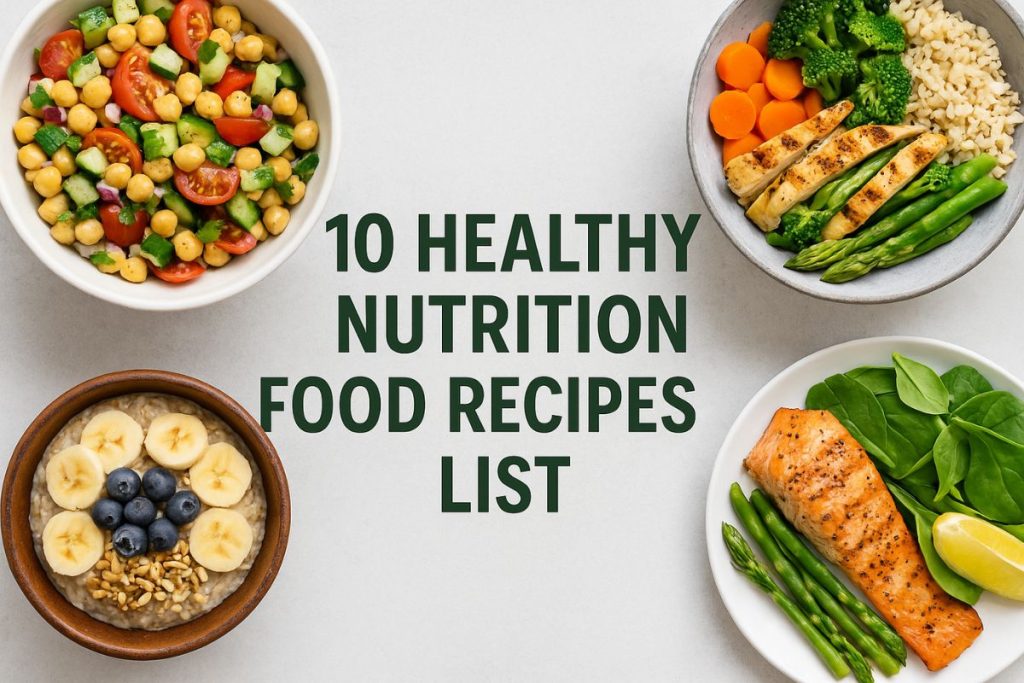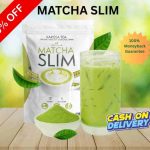Ever wondered how to combine flavor and health on your plate? Finding healthy nutrition food recipes that are both delicious and nutrient-rich can be a fun journey. Eating healthy doesn’t have to be boring – in fact, colorful fruits, veggies, grains, and lean proteins can turn any dish into a tasty adventure! We all know that vegetables and fruits are packed with vitamins, minerals, and fiber. And swapping refined grains for whole grains like quinoa or brown rice adds even more nutrients.
Good nutrition is about including the right mix of ingredients. To build balanced meals, aim to include:
- Fruits and Vegetables: Loaded with vitamins A, C, and fiber. These low-calorie, nutrient-dense foods help you feel full and protect your heart.
- Whole Grains: Such as quinoa, brown rice, or oats. They provide extra fiber and important minerals.
- Lean Proteins: Chicken, fish, beans, tofu, or lentils. Protein helps build muscles and keeps you satisfied after eating.
- Healthy Fats: Sources like avocado, nuts, and olive oil support brain and heart health.
Whether you’re planning meals for Nutrition Month or simply want to boost your daily diet, these healthy food recipes with nutritional information will inspire you. In honor of Nutrition Month, try out these healthy food recipes for Nutrition Month — each includes detailed nutrition facts for easy meal planning.
Key Ingredients for Balanced Meals
Incorporating these food groups into recipes creates variety and keeps meals interesting. For example, adding beans and vegetables to soups or stir-fries guarantees fiber and vitamins, while a sprinkle of nuts or seeds boosts healthy fats and crunch. By cooking with whole ingredients and reading the nutrition facts, you’ll know exactly how nutritious each meal is. This article covers ten distinct healthy nutritional food recipes, each highlighting key nutrients.
Celebrate Nutrition Month with Healthy Meals
Nutrition Month is a great time to experiment with healthy recipes. Try one new dish each week from this list – a hearty soup one night, a colorful salad the next. Focus on the nutrition facts: check that you’re getting plenty of fiber and protein from each meal. For instance, plan to include vegetables in every recipe and add a lean protein or whole grain. Cooking these healthy food recipes during Nutrition Month makes learning about nutrition fun and tasty.
1. Greek Salad with Feta and Olives
Image: Healthy Greek salad with tomatoes, cucumber, olives, and feta cheese.
A classic Greek salad bursts with fresh vegetables and bright flavors. Crisp lettuce, juicy tomatoes, cucumber, red onion, and bell peppers combine to create a low-calorie base rich in vitamins A and C. The Greek twist comes from a sprinkle of feta cheese and a handful of olives. Feta adds calcium and protein, while olives provide heart-healthy monounsaturated fats.
Enjoy this salad as a light lunch or side dish. Even the simple olive oil dressing brings benefits: olive oil’s unsaturated fats can help lower cholesterol and inflammation. To assemble:
- Toss mixed greens (romaine or spinach) with halved cherry tomatoes, sliced cucumbers, sliced red onions, and diced bell peppers.
- Add crumbled feta cheese (about 1 oz) and 4–5 Kalamata olives.
- Drizzle with extra virgin olive oil and a splash of vinegar. Season with salt, pepper, and oregano.
Nutrition Highlights: This salad is low in calories and carbs but high in vitamins and healthy fats. One serving provides a good dose of vitamins A and C from the vegetables. The olives and feta contribute calcium and vitamin A, and the fiber from veggies helps digestion. This is a prime example of a healthy food recipe with nutrition facts that delivers big taste and nutrients.
2. Quinoa Avocado Power Salad
A Quinoa Avocado Salad is a powerhouse of plant-based nutrition. Quinoa is a seed that cooks like a grain and contains all nine essential amino acids, making it a complete protein. One cup of cooked quinoa gives about 8 g of protein and 5 g of fiber. Mix it with creamy avocado for even more nutrients: avocados are rich in heart-healthy monounsaturated fats and fiber.
To make this salad, combine:
- Cooked quinoa (about 1 cup).
- Diced avocado (½ medium avocado).
- Chopped greens (like spinach or kale) for extra vitamins.
- Black beans or chickpeas (for additional protein and fiber).
- Cherry tomatoes, corn kernels, and a squeeze of lime juice.
- Fresh herbs (cilantro or parsley) and a drizzle of olive oil.
Mix all ingredients gently. Season with salt, pepper, and a little cumin or chili powder for flavor. Serve chilled.
Nutrition Highlights: Quinoa provides complex carbs, protein, and fiber, which help you feel full and energized. Avocado adds 8g of fiber and healthy fats. This salad also includes folate, potassium, and antioxidants from the tomatoes. It’s a balanced meal ideal for lunch or a hearty side dish. With nutritious ingredients and nutrition facts at hand, this healthy food recipe delivers sustained energy.
3. Hearty Turkey & Sweet Potato Chili
This Healthy Turkey Chili is a comforting bowl packed with protein and fiber. Using lean ground turkey instead of beef lowers saturated fat and calories, making it a better choice for heart health. We also load the chili with fiber-rich beans (kidney beans, black beans, or pinto beans) which add protein and promote fullness. Fiber from the beans, sweet potatoes, and tomatoes helps digestion and cholesterol levels.
Key ingredients include:
- Lean ground turkey (90% lean or higher).
- Chopped onions, garlic, and bell peppers for flavor and nutrients.
- Diced tomatoes (canned or fresh) for vitamin C and fiber.
- Cooked kidney beans and/or black beans (drained) for protein and fiber.
- Cubed sweet potatoes or canned pumpkin: Sweet potatoes are high in vitamin A, fiber, and potassium, while pumpkin adds fiber and vitamin E.
- Chili spices: chili powder, cumin, paprika, salt, and pepper.
Let everything simmer until flavors meld, about 30 minutes. Serve hot, topped with fresh cilantro or a dollop of plain yogurt (for extra protein and calcium).
Nutrition Highlights: This chili is rich in protein and fiber, which aid muscle building and digestive health. Sweet potatoes/pumpkin boost vitamins A and C, and beans contribute magnesium and folate. It’s also high in antioxidants from tomatoes and spices. By using lean meat and extra vegetables, this healthy food recipe and nutrition-conscious dish is ideal for a filling dinner that keeps you satisfied longer.
4. Baked Salmon with Roasted Vegetables
Fish lovers will enjoy this Baked Salmon dish, which is loaded with omega-3 fatty acids and protein. Salmon is one of the best sources of long-chain omega-3s (EPA and DHA) that reduce inflammation and may lower blood pressure. A 3.5-ounce serving provides over 22 grams of protein, making it excellent for muscle repair and fullness.
Roast or bake salmon fillets with a drizzle of olive oil, lemon slices, and herbs. Serve alongside roasted broccoli, carrots, and bell peppers, or on a bed of steamed brown rice (for extra fiber and whole grains).
Nutrition Highlights:
- Omega-3 fatty acids: Support heart and brain health.
- High protein: ~22–25 g per 3.5 oz of salmon, helping muscle maintenance.
- Vitamins & Minerals: Salmon provides B vitamins (especially B12), vitamin D, and selenium.
- Vegetables: Roasted veggies add vitamins A, C, K, and fiber.
This dish is savory, simple, and supports cardiovascular health with healthy fats and vitamins. It’s a prime example of a healthy nutritional food recipe that’s as delicious as it is nutritious.
5. Lentil Vegetable Soup
A warm bowl of Lentil Vegetable Soup is comforting and nutritious. Lentils are tiny legumes that pack a big nutritional punch: they are high in protein and fiber, yet very low in fat. Half a cup of cooked lentils has about 12 g of protein and 9 g of fiber. This plant-based protein can stand in for meat, and fiber helps manage blood sugar and cholesterol.
To make it, simmer:
- Red or brown lentils (rinsed) in vegetable broth.
- Chopped carrots, celery, onions, and garlic.
- Spinach or kale added near the end for extra vitamins.
- Tomato paste or diced tomatoes for depth and vitamin C.
- Season with turmeric, cumin, and bay leaf.
Let the soup simmer until lentils are soft and flavors meld, about 25–30 minutes.
Nutrition Highlights:
- High in protein & fiber: Keeps you full and supports digestion.
- Rich in iron and folate: Important for red blood cell health.
- Low in fat: Contains no cholesterol, making it heart-healthy.
- Disease-fighting nutrients: Regular legume intake may reduce chronic disease risk.
This soup is hearty and satisfying, ideal for meal prep or cooler nights. It’s an easy healthy food recipe with nutrition facts that delivers a variety of nutrients in one bowl.
6. Blueberry Banana Smoothie Bowl
Start your day with this Blueberry Banana Smoothie Bowl, a sweet and nutritious breakfast treat. Blueberries are often called a “superfood” for good reason: they’re low in calories but high in nutrients and antioxidants. A 1-cup serving (about 150g) of blueberries contains 13% of the daily fiber and 14% of vitamin C, while only 84 calories. Bananas add natural sweetness, potassium, and extra fiber.
Blend:
- Frozen blueberries (1 cup).
- Frozen banana (1 medium).
- A splash of almond milk or yogurt for creaminess.
- Fresh spinach (a handful) for extra greens (optional).
- Chia seeds or ground flaxseed for omega-3 and fiber.
Pour the smoothie into a bowl and top with granola, fresh berries, sliced almonds, or coconut flakes.
Nutrition Highlights:
- Antioxidants: Blueberries have some of the highest antioxidant levels of any fruit. These help fight oxidative stress and inflammation.
- Fiber & Vitamins: Both blueberries and bananas add fiber, vitamin C, and vitamin K, and spinach adds iron and vitamin A.
- Satiety: Chia seeds and nuts contribute healthy fats and protein, keeping you full longer.
This breakfast bowl is a treat for your body and taste buds. It’s like eating fresh fruit with a side of nutrients – great for brain health, digestion, and heart health. It’s a perfect example of a nutrition healthy food recipe that’s easy to blend and enjoy.
7. Veggie Tofu Stir-Fry with Brown Rice
Need a quick dinner? A Vegetable Stir-Fry is a flexible way to use lots of veggies and protein. Stir-fries can include a rainbow of vegetables – broccoli, bell peppers, carrots, snap peas, and mushrooms – all rich in fiber, vitamins, and phytonutrients. Adding tofu or chicken provides lean protein. Soy-based tofu contains all essential amino acids and may even improve heart health.
To make this dish:
- Heat a tablespoon of avocado or canola oil in a wok or large pan.
- Add minced garlic and ginger for flavor.
- Add cubed tofu (or sliced chicken breast) and cook until golden.
- Toss in broccoli florets, sliced bell peppers, carrots, and snow peas. Stir-fry quickly; veggies should stay crisp.
- Season with low-sodium soy sauce or tamari, a squeeze of lime, and chili flakes if you like heat.
- Serve over steamed brown rice or quinoa (for extra fiber and nutrients).
Nutrition Highlights:
- Variety of vitamins: Vegetables provide vitamins A, C, K and minerals like potassium.
- Plant protein: Tofu adds protein and contains plant compounds that support heart health.
- Whole grains: Brown rice adds fiber and minerals, making the meal more filling.
- Quick & Customizable: You can load up on vegetables with few extra calories, making this a low-cost, high-nutrition meal.
A stir-fry is a simple healthy recipe for food and nutrition that’s ready in 15 minutes. It’s a smart way to enjoy lots of vegetables with your choice of protein and whole grains.
8. Avocado Toast with Whole Grain Bread
Sometimes simple is best. Avocado toast on whole-grain bread is a trendy, satisfying breakfast or snack. Avocados provide monounsaturated fats that support heart health and fiber that keeps you full. One half-cup of avocado delivers about 8 grams of fiber (about 30% of daily value), plus vitamins K and B complex.
To prepare:
- Toast a slice of 100% whole grain bread.
- Mash ripe avocado with a fork, mix in lemon juice, salt, and pepper.
- Spread the avocado on the toast.
- Top with a sliced hard-boiled egg or poached egg (for extra protein) and a handful of arugula or sprouts.
- Optional: sprinkle chili flakes, hemp seeds, or a drizzle of olive oil.
Nutrition Highlights:
- Healthy fats & fiber: Avocado provides ~11 g monounsaturated fat per ½ cup and 8 g fiber.
- Micronutrients: Avocado is rich in B vitamins, folate, vitamin K, magnesium, potassium, and a bit of vitamin C.
- Whole grains: The bread adds fiber, B vitamins, and minerals.
- Protein: Adding an egg or beans can boost protein.
This recipe shows how a simple breakfast can be nutrient-dense. Avocado toast is a classic example of a healthy food recipe with nutrition facts: it combines healthy fat, fiber, and whole grains for lasting energy.
9. Chickpea Curry with Spinach
A warming Chickpea Curry (Chana Masala style) is packed with plant protein and spices. Chickpeas are incredibly nutritious: they offer about 15 g of protein per cooked cup and are rich in fiber and folate. They also contain iron and potassium. The fiber and protein in chickpeas help stabilize blood sugar and keep hunger at bay.
To make this curry:
- Sauté onions, garlic, and ginger in a pot.
- Add spices (turmeric, cumin, coriander, garam masala, chili powder).
- Stir in canned diced tomatoes and cooked chickpeas.
- Let simmer to thicken.
- Stir in a big handful of fresh spinach until wilted.
- Finish with a squeeze of lime and fresh cilantro.
Serve over brown rice or with whole-grain naan.
Nutrition Highlights:
- High protein & fiber: A ½-cup of chickpeas provides ~7.5 g protein and 6 g fiber; a full cup is about 15 g protein.
- Blood sugar support: The fiber helps regulate blood sugar levels, which may help reduce diabetes risk.
- Vitamins & Minerals: Spinach adds iron, vitamin C, and calcium; chickpeas supply folate and potassium.
- Anti-inflammatory spices: Turmeric and cumin add flavor and have health benefits.
This curry is a flavorful example of healthy food recipes and nutrition facts working together. It’s vegetarian, gluten-free, and keeps well as leftovers (flavors even deepen the next day!).
10. Colorful Buddha Bowl with Quinoa and Veggies
A Buddha Bowl is a nourishing grain bowl filled with a variety of foods. Start with a base of cooked quinoa or brown rice (for fiber and protein). Top with an array of vegetables (raw and roasted): roasted sweet potatoes or squash, steamed broccoli, shredded carrots, cherry tomatoes, and leafy greens. Add a protein like grilled chicken, tofu, or chickpeas. Include something crunchy (nuts or seeds) and a flavor boost (sliced avocado or a tahini dressing).
For example, one bowl could have:
- ½ cup cooked quinoa (around 110 calories, 4 g protein).
- Roasted sweet potato cubes (vitamin A, fiber).
- Steamed broccoli and cauliflower (vitamins C, K, fiber).
- Sautéed kale or spinach.
- Pan-seared tofu cubes or a boiled egg for protein.
- Avocado slices and a sprinkle of pumpkin seeds (healthy fats and magnesium).
- Drizzle with lemon-tahini dressing (adds calcium from sesame).
Nutrition Highlights:
- Balanced macronutrients: This bowl combines carbs (quinoa), protein (tofu/chicken), healthy fats (avocado, dressing), and fiber (veggies, legumes).
- High in fiber: Multiple veggies, grains, and beans give a fiber-rich meal, which supports digestion and fullness.
- Micronutrient diversity: Eating a rainbow of vegetables supplies vitamins A, C, K, folate and minerals like potassium and magnesium.
- Customizable: Easy to adjust for dietary needs (more protein, less grain, etc.).
A Buddha bowl is a symbol of balanced nutrition. It’s colorful and fun to assemble – you can literally see the nutrients. This healthy nutritional food recipe reminds us: mixing different foods can create a wholesome, satisfying meal.
Conclusion: Embrace Healthy Nutrition Food Recipes
These 10 recipes prove that healthy nutrition food recipes can be flavorful, satisfying, and versatile. By using a mix of vegetables, fruits, whole grains, lean proteins, and healthy fats, each dish delivers key nutrients. Remember, reading nutrition facts and information can help you build balanced meals. For example, knowing quinoa provides 8 g protein and 5 g fiber or that lentils offer 12 g protein per serving empowers you to make smart choices.
Whether you’re celebrating Nutrition Month or simply looking to eat better, incorporating these recipes into your meal plan is a great start. From the antioxidant power of blueberries to the healthy fats in avocado and salmon, each recipe focuses on nutrition and taste. Enjoy these meals knowing they contribute to your well-being with whole-food ingredients and clear nutrition facts. These dishes make tasty and nourishing meals – truly healthy recipes for food and nutrition.
Stay curious about nutrition—because eating well is not just about restriction, but about nourishing your body with delicious, wholesome foods.

FAQs
Q: What exactly are healthy nutrition food recipes?
A: Healthy nutrition food recipes are meals built around whole, unprocessed ingredients and balanced nutrients. They typically include plenty of vegetables, fruits, whole grains, lean proteins, and healthy fats. For example, a Greek salad packed with veggies and olive oil, or a quinoa bowl loaded with colorful vegetables and chickpeas. Each recipe focuses on natural ingredients and comes with nutritional information (calories, fiber, protein, etc.) so you know exactly what you’re getting.
Q: Why should I look for healthy food recipes with nutrition facts?
A: Nutrition facts help you understand what you eat. By checking calories, protein, fiber, vitamins and minerals in a recipe, you can ensure your meal meets your health goals. For instance, knowing a smoothie provides 5g fiber or that a soup gives 12g protein helps you plan balanced meals. Each recipe here lists its nutrition details (calories, carbs, protein, etc.), providing healthy food recipes nutrition facts at a glance. This makes it easy to track nutrients and balance your intake.
Q: Can I use these healthy food recipes for Nutrition Month events?
A: Absolutely! These recipes are perfect for Nutrition Month or any healthy eating initiative. During Nutrition Month, you could try one recipe each week from this list. Focus on the nutrition facts provided: aim to include fiber-rich veggies, lean proteins, and healthy fats daily. For example, pick the quinoa avocado salad or lentil soup on days you want extra plant protein. Preparing these dishes encourages long-term healthy eating habits beyond the month.
Q: Are these recipes suitable for special diets (vegetarian, gluten-free)?
A: Many of these recipes are easy to adapt. Vegetarians can use tofu, lentils, chickpeas, or beans instead of meat. For gluten-free diets, choose gluten-free grains like rice or quinoa and avoid wheat-based products. For example, the Buddha bowl and lentil soup are naturally gluten-free. Always check labels, but because this list emphasizes whole foods, making a substitute is simple (swap pasta for brown rice, etc.).
Q: How can I meal-prep using these healthy recipes and nutrition facts?
A: Most of these recipes make multiple servings and store well. You can cook a big pot of chili or soup and portion it out for the week. Use the nutrition facts to portion your meals: if a serving has 500 calories and 20g protein, balance it with snacks and other meals. Pre-chop veggies and cook grains in advance to quickly assemble bowls or stir-fries. Having these healthy recipes ready can help you stick to your nutrition goals each day.
READ LAST POST: Healthy Dog Food , Best Healthy Fast Food , Health Benefits Of Cumaseba






2 thoughts on “10 healthy nutrition food recipes list”